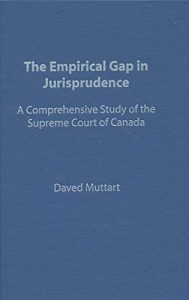In jurisprudential writing, single decisions are often held up as representative without any evidence to support their representative claims. In order to address this problem, Daved Muttart has made a systematic study encompassing every judgment of the Supreme Court of Canada between 1950 and 2003.
Examining almost 5000 cases, Muttart analyses these Supreme Court decisions employing several important criteria including whether the decisions overruled prior precedent, the extent to which they were decided on fact, law, or policy, and the legal and extra-legal modes of reasoning utilized by the Court. Muttart uses the results of this systematic examination to test the validity of extant jurisprudential theories. Ultimately, he concludes that the Court's method of operation is evolving as it moves into a new century. While the court's reasoning is becoming less foundational, it remains a predominantly legal, as opposed to political, institution.
Filling an important niche in the study of jurisprudence, The Empirical Gap in Jurisprudence demonstrates that systematic studies based on large samples of cases will yield many insights that were obfuscated by prior efforts that relied on small and self-selected samples.



